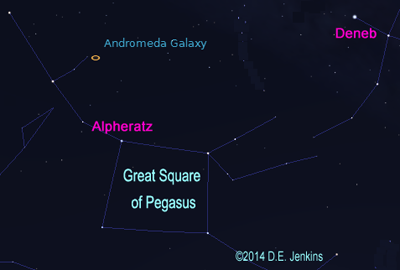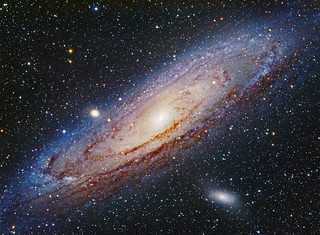
December 2014 - Vol. 18, No. 12
This Month's Night Sky - NOTE: The next paragraph describes the sky as it appears at 10 pm EST (11 pm EDT) near mid- month. The sky also looks this way at 11 pm EST (midnight EDT) during the beginning of the month and at 9 pm EST (10 pm EDT) by month's end.
If you are blessed with a dark observing site, the Orion arm of the Milky Way (the galaxy we inhabit) arches overhead from horizon to horizon. Embedded are the stars of Constellations Cassiopeia, denoted by its familiar "W" or Sigma asterism, and Perseus. The Summer Triangle finally disappears in the W. Although there are no bright stars due S., red Aldebaran and the tiny dipper asterism of the Pleiades’s, a famous open star cluster (Taurus), as well as yellow Capella (Auriga) glow in the SE. Later follows the twins, Castor and Pollux (Gemini), and the hour-glass asterism of Constellation Orion with fuzzy M42 (Great Orion Nebula) just below its three "belt" stars, which heralds the coming of winter.
MERCURY will not be visible until late December, it will low on the southwestern horizon and will require a site with a good horizon to observe. VENUS returns to the evening sky in December. JUPITER rises in the evening sky, begins retrograde motion on December 9. Once again, the giant planet and the first magnitude star, Regulus continue the planetary dance. MARS in Capricornus sets about 3 hours after the Sun. SATURN reappears in the morning sky. URANUS sets around midnight. Comet Lovejoy is expected to become brighter than 6-magnitude and will be appearing in the constellation of Lepus later in the month. Get out your binoculars! This comet should survive perihelion as it doesn't come as close to the Sun as the Earth does. Perihelion date is January 30.
Review how to determine Angular Measurement.
Calendar of Events
NOTE: For those observers not in the ET zone, convert the calendar times to your zone's time by subtracting one hour for CT, two for MT and three for PT. Don't forget to adjust for Daylight Savings Time when necessary by subtracting one hour from your planisphere's time. Dawn and dusk times must also be corrected. See your local newspaper, TV news, or cable TV's Weather Channel for sunrise and sunset times. Unfortunately some of these events may occur during daylight hours in your area.
| DATE | EVENT |
| 02 | Uranus 1.2 deg S of Moon, an actual occultation from Eastern Canada, Alaska and the arctic region. |
| 06 | Aldebaran 1.4 deg S. of the Moon. |
| 08 | Mercury at aphelion and superior conjunction. |
| 19 | Saturn 1.5 deg N. of Moon. |
| 12 | Mars at perihelion. Moon at apogee. Jupiter 5 deg N. of Moon. |
| 14 | Geminids meteor shower peak. This shower can produce up to 120 meteors per hour at its peak. The moon is at last quarter this year and the show may be spectacular |
| 20 | Ursid meteor peak. This is a minor shower with a peak of about 10 meteors per hour. |
| 21 | Winter solstice |
| 24 | Moon at perigee. |
| 25 | Mars 6 deg S. of Moon. Observe about 30 minutes after sunset. |
| 23 | Venus 6 deg S. of Moon. The moon will be a crescent above the southwest horizon. |
| 29 | Uranus 1 deg S. of Moon, this will be an occultation from Japan, eastern Russia, western Canada and Alaska. There is a great opportunity at the end of December to watch three planets - - Mars, Venus and Mercury. |
Lunar Almanac for December 2014
| Phases of the Moon | Phase and Date(s) | Best viewed before local midnight |
 |
New 22 |
Deep Space Objects |
 |
1st. Qtr 29 |
Planets & Moon |
 |
Full 6 |
Moon |
 |
Last Qtr 14 |
Deep Space & Planets |
Deep Sky Splendor: the Andromeda Galaxy
The fall sky is filled with the bright star clouds of the Milky Way running from the south western horizon toward the north east through the constellations of the Summer Triangle, that is now past the zenith for northern locations when the last gasp of twilight fades. Following the triangle, a Great Square formed by four fairly bright stars, one of them Alpheratz that really belongs to a neighboring constellation.. Galloping toward zenith, Pegasus, the flying horse carries with it the most distant galaxy that is easily visible by the naked eye.

Known as M31, or the Andromeda galaxy is the brightest object outside of the Milky Way that is easily visible with the naked eye. It is a whopping 2,538,000 light years away and still covers 3 degrees of the night sky. In contrast, the full moon only covers half a degree.
Andromeda is a spiral galaxy, 110,000 light years in diameter containing a trillion stars. It is a splendid object from a dark site. Field glasses will reveal a well-formed oval cloud, because the spirals tipped about 15 degrees toward the Earth rather than edge-on or facing. Even so, an amateur telescope can reveal its central nucleus and good images reveal the dark veins of its spiral arms. Classified as a Sb spiral, the galaxy’s central bulge is composed of yellow stars while blue stars are more concentrated in its arms.
Andromeda and the Milky Way galaxy, along with M-33 in Triangulum, are the largest members of our Local Group that is, a number of galaxies that are gravitationally bound. The Local Group is thought to contain about 30 members, most of these are dwarf galaxies like the Large and Small Magellanic Clouds visible from the southern hemisphere. The “Clouds” are dwarf galaxies that are tightly bound to the Milky Way. Andromeda also has a number of dwarf companions. Notably, NGC 205 and M32 are often visible on images with the main spiral. There are two more members of Andromeda’s family, NGC 185 and NGC147 that are located in the nearby constellation of Cassiopeia.
This image is a composite of images of the Andromeda galaxy and the two nearby companions that were taken by Terry Hancock in August of 2012 and edited to produce this beautiful result. Visit Terry's Down Under Observatory for great astrophotos that may be purchased. You may also like Terry's "Sagittarius Starscape" featured on theAstronomy Picture of the Day (APOD)site on September 5, 2014! Many thanks to Terry for sharing this astrophoto with readers of the What's up? almanac!
It is possible that Andromeda and Milky Way collided 10 billion years ago and it is also possible that they will collide again in another 4 billion years. Although this collision might mean the end of Milky Way and Andromeda, it may be that a new, larger elliptical galaxy will result. In any case, we can sit back and enjoy the sight of this massive, distant spiral from a deep sky site free from worry. Some night when the conditions are just right and the site is dark enough, you might catch a glimpse of a huge oval cloud that you'll never forget.
--See You Under the Stars!
Astra for Astra's Almanac
This installment of "Whats Up?" is ©2014 by Dawn Jenkins for Astra's Stargate. View Ron Leeseburg's Farewell Issue for information on where to find information such as is presented in this almanac.
